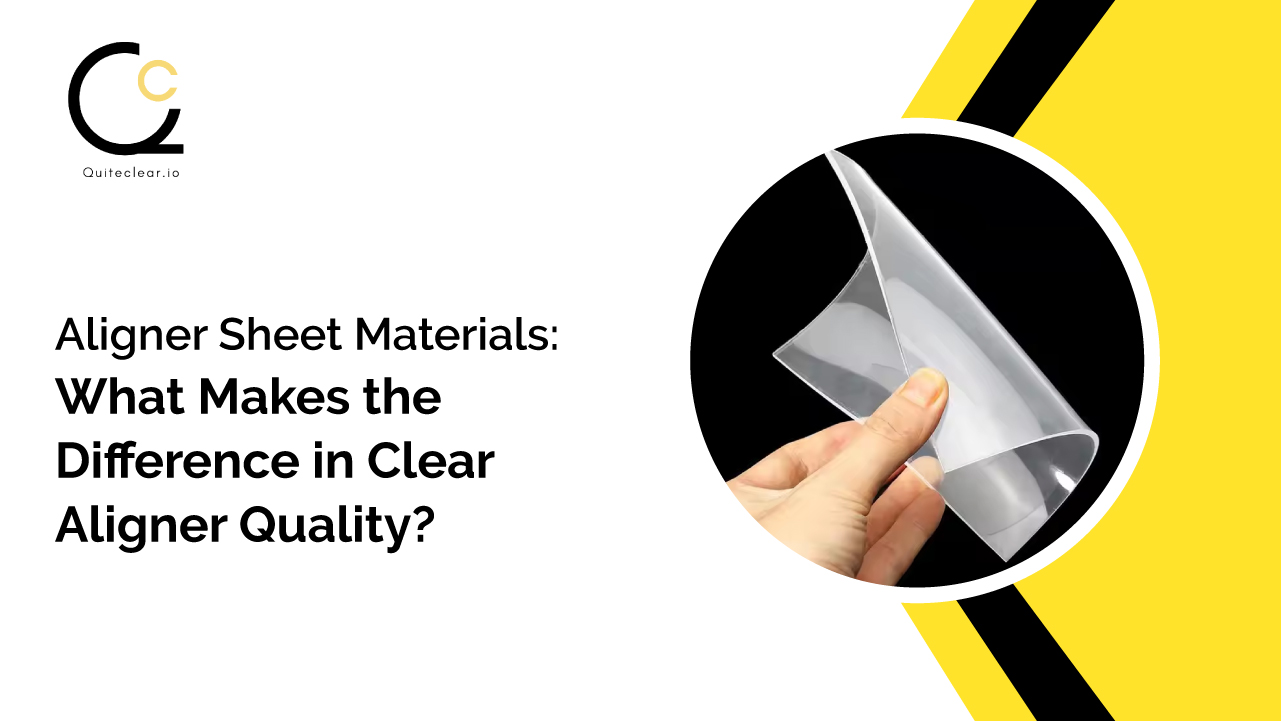Aligner Sheet Materials: What Makes the Difference in Clear Aligner Quality?

With the growing demand for orthodontic solutions among adults and adolescents, clear aligners have quickly become a popular alternative to traditional braces. Not only are they a more aesthetically pleasing option for teeth alignment, but they also enhance comfort and simplify oral hygiene. However, a critical factor affecting the effectiveness, comfort, and durability of clear aligners is the material from which they are made. This guide explores the materials used in clear aligner manufacturing and examines their impact on overall aligner quality.
1. Importance of Material in Clear Aligner Quality
Clear aligner materials are fundamental to their clinical performance, patient comfort, and durability over time. For high-quality aligners, materials must possess resilience, transparency, and the ability to apply consistent force for effective tooth movement. Currently, two primary production processes exist for clear aligners:
- Vacuum Thermoforming: Thermoplastic materials are heated and molded to fit customized models, offering a high degree of precision.
- Direct 3D Printing: While currently limited by material choices, this process is advancing as new materials are developed, potentially enabling even more customized aligner solutions.
Both production methods require materials that balance flexibility with durability, underscoring the importance of choosing the right material for both manufacturers and consumers.
2. Types of Materials Used in Clear Aligners
Clear aligners are mostly made from thermoplastics, primarily divided into amorphous and semicrystalline polymers. Here’s a closer look at each type:
- Amorphous Polymers: These polymers have an irregular molecular structure, resulting in high transparency and impact resistance, ideal for maintaining aesthetic appeal.
- Semicrystalline Polymers: Known for their toughness and chemical resistance, these polymers offer enhanced durability and are often combined with amorphous polymers to optimize performance.
3. Polymer Blends for Enhanced Performance
To improve the functionality and patient experience with clear aligners, many manufacturers use polymer blends. By mixing materials like PETG, PC, and TPU in specific ratios (e.g., PETG/PC/TPU in a 70/10/20 ratio), these blends exhibit enhanced strength, flexibility, and resilience. This approach allows manufacturers to customize aligners based on patient needs and clinical goals, offering a balance of strength and flexibility for optimal performance.
4. Choosing the Right Material for Clear Aligner Quality
For both patients and practitioners, understanding the properties of aligner materials can assist in selecting the right product based on clinical needs:
- Comfort and Flexibility: For patients with sensitivity concerns, materials like TPU are preferred for their elasticity and comfort.
- Durability: When aligners must withstand higher levels of pressure, PETG or PC-based options are recommended due to their rigidity and resistance.
- Transparency: For aesthetic appeal, amorphous polymers like PETG and TPU offer excellent clarity, enhancing the aligner’s discretion.
5. Future Trends in Aligner Material Development
The evolution of aligner technology is rapidly accelerating, with significant strides being made in material science to enhance both user experience and environmental sustainability. One prominent trend is the development of eco-friendly materials aimed at reducing the environmental impact of clear aligners. As sustainability becomes a priority across industries, many companies are exploring bio-based and biodegradable polymers that maintain the high standards of durability and transparency necessary for orthodontic effectiveness. Such materials offer the promise of reducing waste in aligner production and making disposal more environmentally friendly.
Another major trend is the push toward biocompatibility, with companies aiming to create aligner materials that minimize the risk of allergic reactions or discomfort for patients. Biocompatible materials are specifically engineered to interact safely with the body, reducing irritation and ensuring a comfortable experience for extended wear. As more patients seek orthodontic solutions, the demand for hypoallergenic materials is growing, driving manufacturers to innovate in this area.
Additionally, advancements in 3D printing technologies are transforming the way aligners are produced. Previously limited by material choices, 3D printing is now benefiting from new polymer formulations that allow for greater customization and precision in aligner design. This technology enables manufacturers to create aligners with more intricate detailing, tailored to individual patient profiles, thus enhancing the accuracy and efficiency of treatment. Combining advanced polymers with precise 3D printing opens the door to creating aligners that are not only more comfortable but also more effective in achieving orthodontic goals.
Conclusion
The material composition of clear aligners plays a vital role in determining their performance, durability, and comfort. As the orthodontic field continues to grow, so too does the need for clear aligners made from advanced, high-quality materials that can meet diverse clinical requirements. Whether focusing on highly resilient thermoplastics, flexible polymer blends, or cutting-edge biocompatible solutions, each material offers unique benefits that address specific patient needs. For practitioners and patients alike, a deeper understanding of these material differences can lead to more informed choices, ensuring that aligners provide optimal support for successful, comfortable treatment. As material science and production technologies advance, the future holds exciting possibilities for the clear aligner industry, promising products that are more sustainable, customized, and effective than ever before.
Private-label manufacturers like Quiteclear offers a wide range of proven clear aligner brands to choose from. Connect with them to know more about what is the right fit for you and your patients to get an insight of various brand performances and comparisions and what you are looking for in terms of durability, flexibility, budget-wise etc. when making the choice of choosing a material to manufacture one over the other.
